The Harley-Davidson Factory Tour
I TOOK THE HARLEY-DAVIDSON FACTORY TOUR
While on a business trip (my day job) to Kansas City MO, I visited Harley-Davidson’s Vehicle & Powertrain Operations, a 358,000 square-foot facility. Time for some disclaimers. First off, without special arrangements (which I’m working on), you can’t take any photos inside the factory, only in the public areas. Second, this is that magic time of year when they switch over from making 2017-models to making the 2018s, so about half of the factory was closed to viewing. So, following are the photos that I was able to take myself, within the public lobby area, and some photos I took of the pictures they had on display of the production process. So if you see a photo with guys on the assembly line building bikes, that’s a picture-of-a-picture, and will have to suffice, with my apologies, until I can get back there for a real photo shoot. But I did take an excellent tour of the Harley-Davidson factory, and while I couldn’t take photos, I learned a lot. The change-over to the new models will be complete by the first week in August, when they have their annual 2-day Open House, kicking off production of the new bikes. More on that down the road…
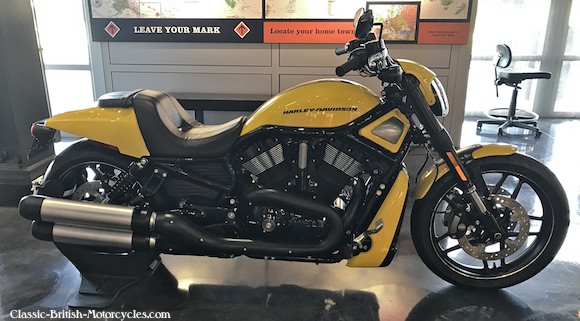
HARLEY-DAVIDSON FACTORY TOUR:
BUILDING WORLD-CLASS MOTORCYCLES
H-D builds a variety of bikes at their Kansas City plant including the new 500 and 750 Street (above), myriad Sportsters (below), Dynas, and some Softails. They also do the final assembly of all 500 and 750 Street engines, which are based on the now-defunct V-Rod design (2017 was the last year for the V-Rod).
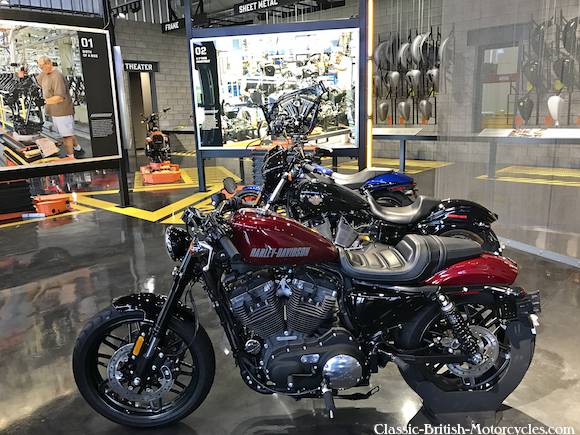
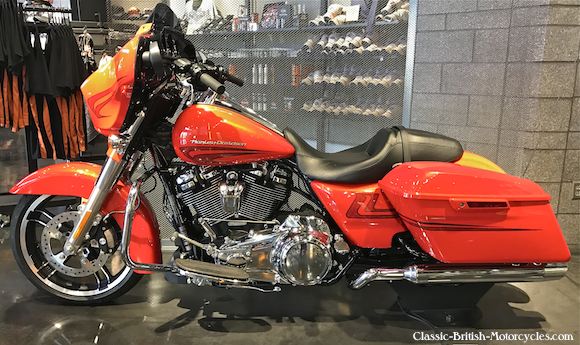
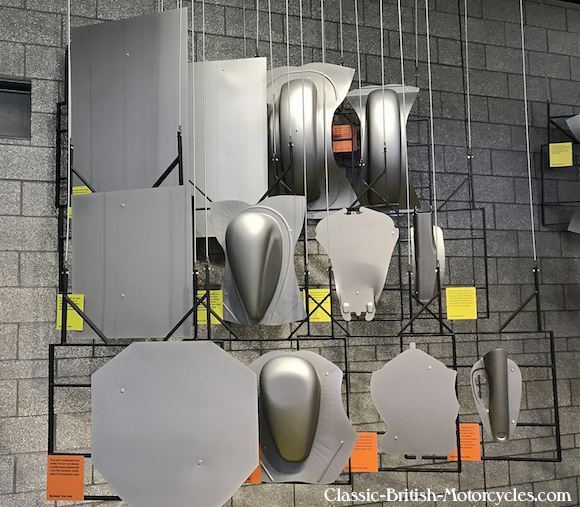
ABOVE: Here, flat sheet metal is laser-cut to shape then stamped out in towering presses, progressing from left-to-right.
HARLEY-DAVIDSON FACTORY TOUR – STEEL DREAMS
While the factory floor was off limits for cameras, they put on several very comprehensive displays in their lobby. Above & below shows the process of taking a flat piece of sheetmetal and turning into tanks and fenders. By the way, every ounce of steel used to build a Harley-Davidson is American steel. Buy American-Hire American. The President didn’t have to tell Harley-Davidson, they were already doing it.
BELOW: The stamped pieces are then trimmed with a laser cutter, then in the case of the tanks, welded together. All very state-of-the-art. The factory floor is as modern as any heavy industry anywhere in the world.
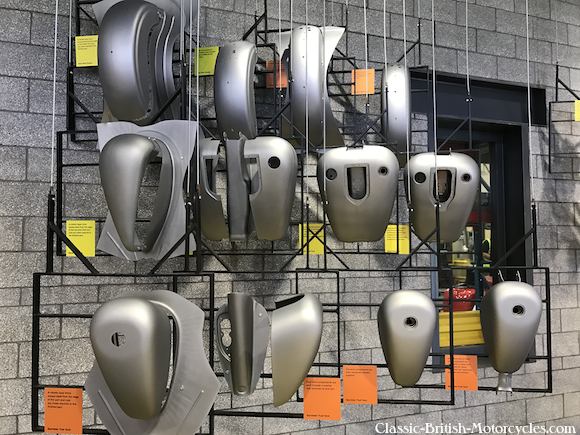
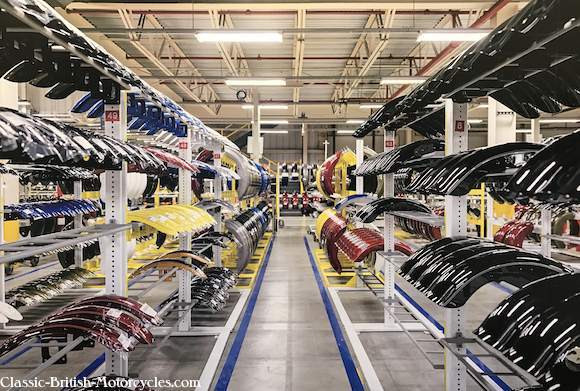
HARLEY-DAVIDSON FACTORY TOUR:
BIG PARTS BUSINESS
Harley-Davidson’s Kansas City plant also makes tons of spare parts for their bikes. Sheetmetal parts seem to be the specialty here, with rows of finished tanks and fenders waiting to be shipped out or bolted to a new bike.
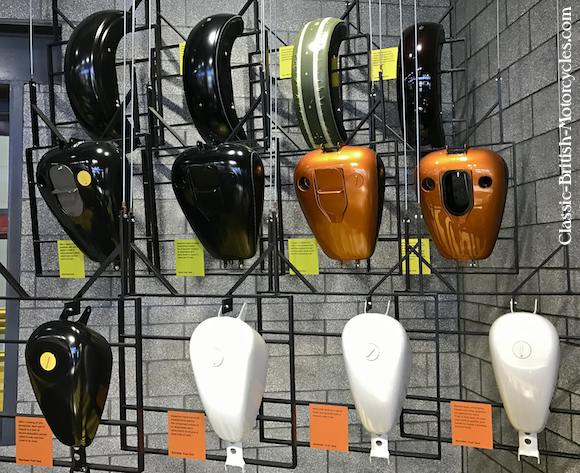
ABOVE: To make every new Harley-Davidson look as gorgeous as they do, the factory puts each part through numerous steps in a process. Every step is backed up by vigilant quality control, catching flaws right away, then either fixing them on the line, or rejecting the part.
BELOW: Here is just a small sample of the finished product. Harley tanks are always stunning. Robots do the painting these days, even the pinstriping, but humans check it all and make sure its right. Every pinstripe, for instance, is inspected, and any flaws are touched up by hand. No tank or fender, or any part for that matter, leaves the Harley-Davidson factory unless its perfect.
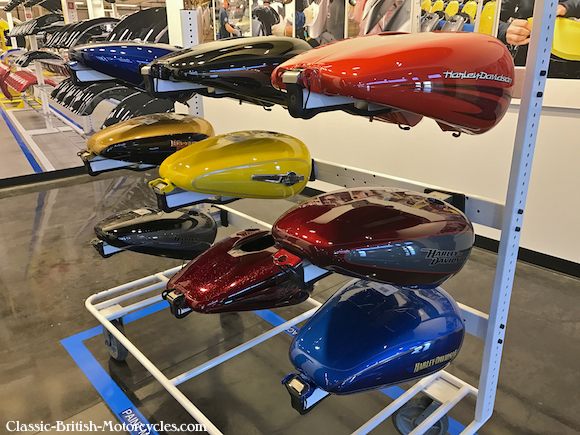
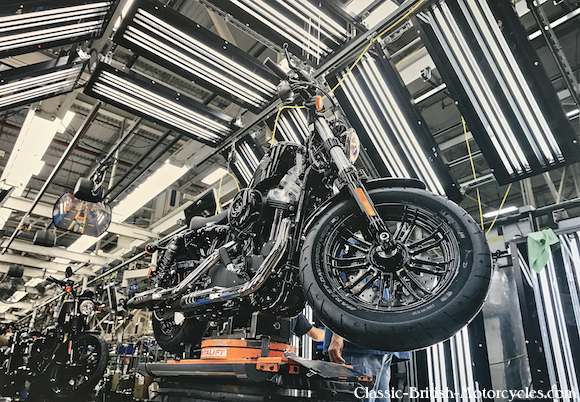
HARLEY-DAVIDSON FACTORY TOUR – THE FACTORY
The bottom 3 photos here are pictures-of-pictures, again because I couldn’t take photos in the factory on this tour. This will have to do for now. But what I saw with my eyes on the factory floor was immensely impressive. To begin with, it’s a totally modern plant, built in 1998, opened in 1999, and it’s brightly lighted and clean-as-a-whistle. You could literally eat off of any surface in the place. While the workers hustled around, and the place was buzzing with activity, you could instantly see how well-organized and well-timed it all is. Partially-assembled bikes crawl down a mechanized assembly line at 3 feet-per-minute, as workers bolt things on, and the bike begins to take shape.
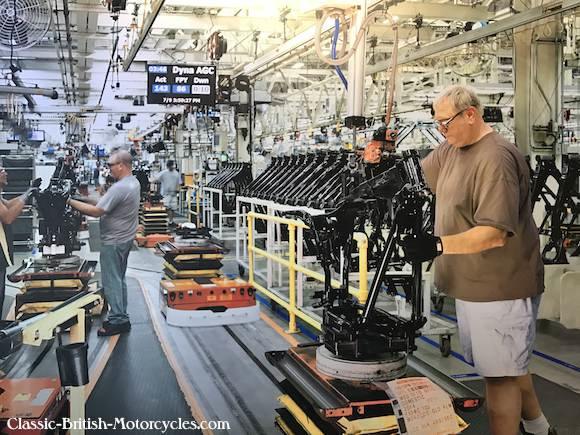
ABOVE: To become a factory worker at Harley-Davidson, those who pass the first level of interviews are invited back for a second round. They are left in a room with a box, and are told they have 30 minutes. Little else is said. If they open the box, they’ll find a rear fender and all the parts needed to assemble it, along with a set of instructions and all the tools needed to complete it. Some people sit there waiting for instruction and never open the box. Others open it, but can’t figure out how to put the fender together. It’s a test of the workers’ reasoning powers as much as it is his/her mechanical skills. They want people who not only can follow instructions, but can think for themselves. The result is a dedicated workforce of over 1,000 employees who love their jobs and ride to work on their own Harleys.
BELOW: The yellow-and-black pedestal that the bike sits on is amazing in itself. It can raise or lower the bike (including adjusting for the height of the workers), and swivel the bike 360-degrees. Workers change jobs every 3 hours to keep it fresh.
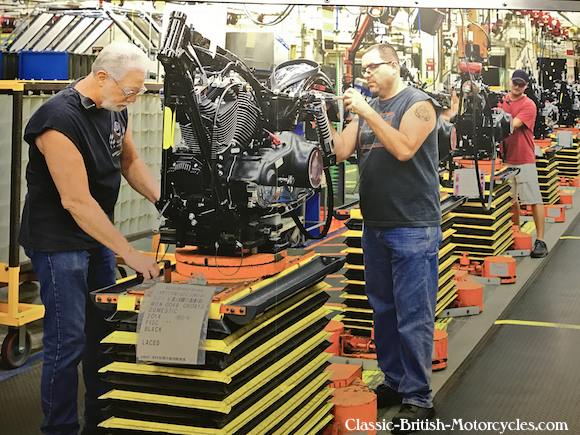
HARLEY-DAVIDSON, THE COMPANY
I’ve been hearing great things about Harley-Davidson for years. I also own a Harley myself (2008 Dyna Street Bob), along with my Brit bikes. But taking this factory tour showed me a whole new aspect of Harley-Davidson the Company. For instance, they are very environmentally-conscious, have perfected their operation to a point where last year they had no waste leaving the facility for landfills 10 out of 12 months. That’s pretty impressive, considering the massive volumes of materials that enter. Of course all the metal is recycled, along with packaging. Even the food waste from their massive lunch room is composted and used as fertilizer for their farmland. Farmland? Yep, Harley bought all the farmland adjacent to their Kansas City factory. Workers can volunteer to work a plot of land and raise crops. The crops are then donated to the local food banks. Because that’s what Harley does. They’ve raised over $85 Million for MDA (Muscular Dystrophy Assn) and untold millions for Veterans and other worthy causes. This is just the tip of the iceberg. I came away so impressed, not just with this gleaming factory, but the company that runs it and the values that they keep. It made me proud to be a Harley owner, but even more so, proud to be an American.
And so ends our Harley-Davidson Factory Tour. If you ever get the chance to tour this facility, or any other Harley plant, do it. It’s a trip worth taking.



No Comment